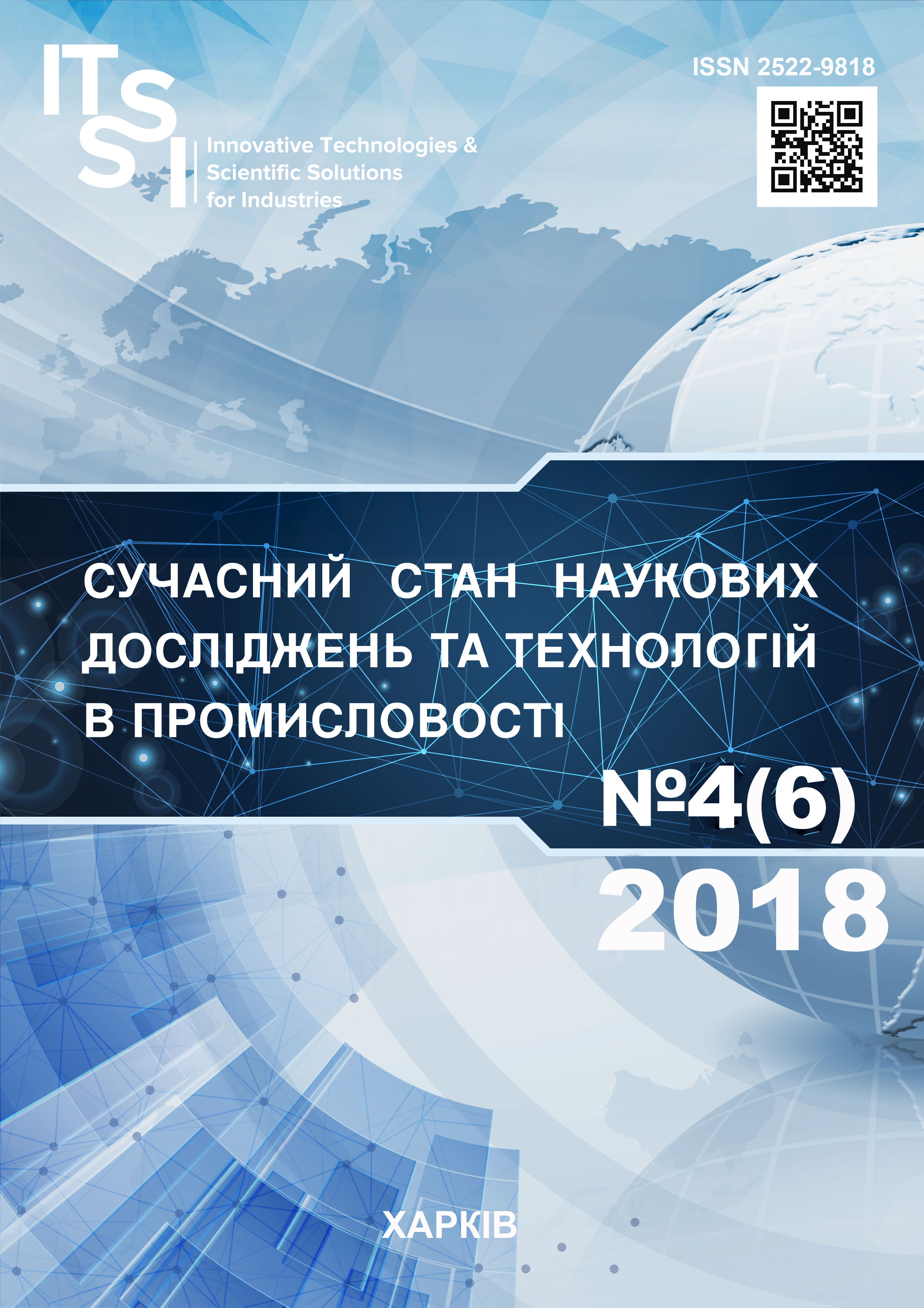МЕТОД МОДЕЛЮВАННЯ ПАРАМЕТРІВ МЕРЕЖІ ПЕРЕДАЧІ ДАНИХ ДЛЯ ЇЇ МОДЕРНІЗАЦІЇ
DOI:
https://doi.org/10.30837/2522-9818.2018.6.015Ключові слова:
мережа передачі даних, імітаційне моделювання, системна динаміка, модель OSI, фізичний рівень, канальний рівень, мережевий рівень, транспортний рівень, трафікАнотація
Предметом дослідження в статті є процес передачі даних в транспортних мережах зв’язку. Мета роботи – розробка методу моделювання параметрів мереж передачі даних, який дає змогу формалізовано представити параметри функціонування мережі для моделювання її поведінки з урахуванням динаміки трафіку. В статті вирішуються наступні завдання: обґрунтування важливості модернізації мереж передачі даних на прикладі зростання їх використання; визначення необхідності створення саме автоматизованого засобу для моделювання, на відміну від залучення технічних спеціалістів; вибір рівнів абстракції мережі передачі даних для її моделювання; визначення математичного апарату для обчислення параметрів моделі; розробка методу моделювання мережі передачі даних. Використовуються такі методи: основи системного аналізу, метод імітаційного моделювання. Отримано наступні результати: Надано прогнозований графік зростання обсягів трафіку за категоріями та узагальнена діаграма. Зроблено висновок, що зростання трафіку відбувається у геометричній прогресії. Була оцінена модернізація мережі з урахуванням різних видів витрат. Зроблено висновок про потребу ринку в автоматизованому інструменті проектування та модернізації мережі. Розглянуті різні способи моделювання динамічних систем; визначений спосіб створення моделі транспортної мережі зв’язку. Розглянута семирівнева модель OSI та наведено власну інтерпретацію особливостей її рівнів. Були обрані чотири нижні рівні цієї моделі, у якості рівнів абстракції моделювання, виділені основні характеристики транспортної мережі зв’язку, якими буде оперувати модель. Функціонування нижніх рівнів транспортної мережі зв’язку формалізовано у вигляді окремих математичних моделей та формул, на основі яких описаний метод моделювання функцій транспортної мережі зв’язку. Були визначені способи застосування цього методу для модернізації топології транспортної мережі зв’язку. Висновки: Таким чином, створено новий метод моделювання транспортної мережі зв’язку, який удосконалює, та спрощує процес створення, або модернізації мережі, що дає можливість значно зменшити кошти на проектування топології мережі, та підвищити утилізацію її ресурсів.Посилання
Nerush, V. B., Kurdecha, V. V. (2012), Simulation of systems and processes [Imitatsiyne modelyuvannya system ta protsesiv], National Technical University of Ukraine "KPI", 115 p. [in Ukrainian].
Nevliudov, I., Tsymbal, O., & Bronnikov, A. (2018), "Intelligent means in the system of managing manufacturing agent", Innovative Technologies and Scientific Solutions for Industries, No. 1 (3), P. 33–47. DOI: https://doi.org/10.30837/2522-9818.2018.3.033.
Averyn, G. V. (2014), Systemdynamics [Sistemodinamika], Donetsk: Donbass, 403 p. [in Russian].
The AnyLogic Company. Discrete Event Simulation Modeling [Diskretno-sobytiynoye imitatsionnoye modelirovaniye], available at: https://www.anylogic.ru/use-of-simulation/discrete-event-simulation/ (last accessed 03.12.2018).
Ducard, G. Modeling and Analysis of Dynamic Systems, available at: https://www.ethz.ch/content/dam/ethz/special-interest/mavt/dynamic-systems-n-control/idsc-dam/Lectures/System-Modeling/Slides_HS17/SysMod2017_Lect1.pdf (last accessed 03.12.2018).
Kovalenko, A., Kuchuk, H., & Ruban, I. (2018), "Using time scales while approximation the length of computer networks" ["Ispolzovanie vremennyh shkal pri approksimacii dliny ocheredej v kompjuternyh setjah"], Innovative Technologies and Scientific Solutions for Industries, No. 2 (4), P. 12–18. DOI: https://doi.org/10.30837/2522-9818.2018.4.012. [in Russian].
Kosenko, V., Persiyanova, E., Belotskyy, O., Maleyeva, O. (2017), "Methods of managing traffic distribution in information and communication networks of critical infrastructure systems", Innovative Technologies and Scientific Solutions for Industries, No. 2 (2), P. 48–55. DOI: https://doi.org/10.30837/2522-9818.2017.2.048.
Wilensky, U., William, R. (2015), An Introduction to Agent-Based Modeling, MIT Press, 504 p.
Minigraph Talking Pages, Computer Network Models, available at: https://www.minigranth.com/computer-networks-tutorial/computer-network-models/ (last accessed 03.12.2018).
Mobile technology trends: traffic by application category, available at: https://www.ericsson.com/en/mobility-report/mobile-traffic-by-application-category (last accesed 03.12.2018).
Cisco, V. N. I. "Traffic Analysis", available at: https://www.cisco.com/c/en/us/td/docs/ios/solutions_docs/voip_solutions/
TA_ISD.html (last accesed at 03.12.2018).
Cisco, V. N. I. "Cisco Visual Networking Index: Forecast and Trends, 2017–2022", available at: https://www.cisco.com/c/en/us/solutions/collateral/service-provider/visual-networking-index-vni/white-paper-c11-741490.html (last accessed at 03.12.2018).
Kosenko, V., Maleyeva, O., Persiyanova, E., Rogovyi, A. (2017), "Analysis of information-telecommunication network risk based on cognitive maps and cause-effect diagram", Advanced Information Systems, Vol. 1, No. 1., P. 49–56. DOI: https://doi.org/10.20998/2522-9052.2017.1.09 [in English].
Shaw, K "The OSI model explained: How to understand (and remember) the 7 layer network model", available at: https://www.networkworld.com/article/3239677/lan-wan/the-osi-model-explained-how-to-understand-and-remember-the-7-layer-network-model.html (last accessed at 03.12.2018).
Reva, O. A., Davydovskyi, Y. K. (2018), "Method of the network topology transformation to quasihomogeneous structure" ["Rozrobka metodyky modernizatsiyi topolohiyi merezhi dlya otrymannya kvaziodnoridnoyi struktury"], Radioelectronic and computer systems, No. 2, P. 43–51. DOI: https://doi.org/10.32620/reks.2018.2 [in Ukrainian].
##submission.downloads##
Опубліковано
Як цитувати
Номер
Розділ
Ліцензія
Авторське право (c) 2018 Юрій Костянтинович Давидовський, Олександр Анатолійович Рева, Ольга Володимирівна Малєєва

Ця робота ліцензується відповідно до Creative Commons Attribution-NonCommercial-ShareAlike 4.0 International License.
Наше видання використовує положення про авторські права Creative Commons для журналів відкритого доступу.
Автори, які публікуються у цьому журналі, погоджуються з наступними умовами:
Автори залишають за собою право на авторство своєї роботи та передають журналу право першої публікації цієї роботи на умовах ліцензії Creative Commons Attribution-NonCommercial-ShareAlike 4.0 International License (CC BY-NC-SA 4.0), котра дозволяє іншим особам вільно розповсюджувати опубліковану роботу з обов'язковим посиланням на авторів оригінальної роботи та першу публікацію роботи у цьому журналі.
Автори мають право укладати самостійні додаткові угоди щодо не комерційного та не ексклюзивного розповсюдження роботи у тому вигляді, в якому вона була опублікована цим журналом (наприклад, розміщувати роботу в електронному сховищі установи або публікувати у складі монографії), за умови збереження посилання на першу публікацію роботи у цьому журналі.
Політика журналу дозволяє і заохочує розміщення авторами в мережі Інтернет (наприклад, у сховищах установ або на особистих веб-сайтах) рукопису опублікованої роботи, оскільки це сприяє виникненню продуктивної наукової дискусії та позитивно позначається на оперативності та динаміці цитування опублікованої роботи.














